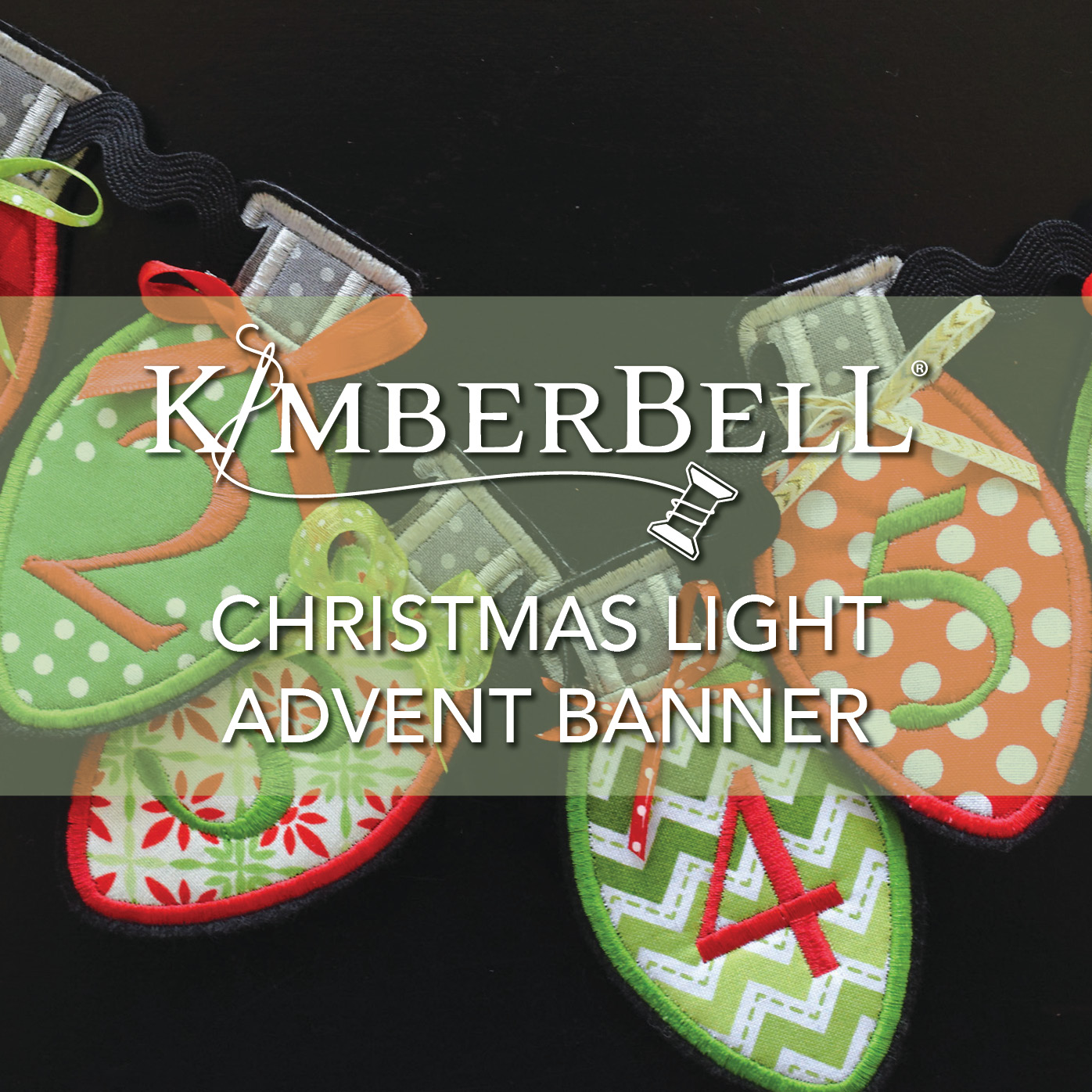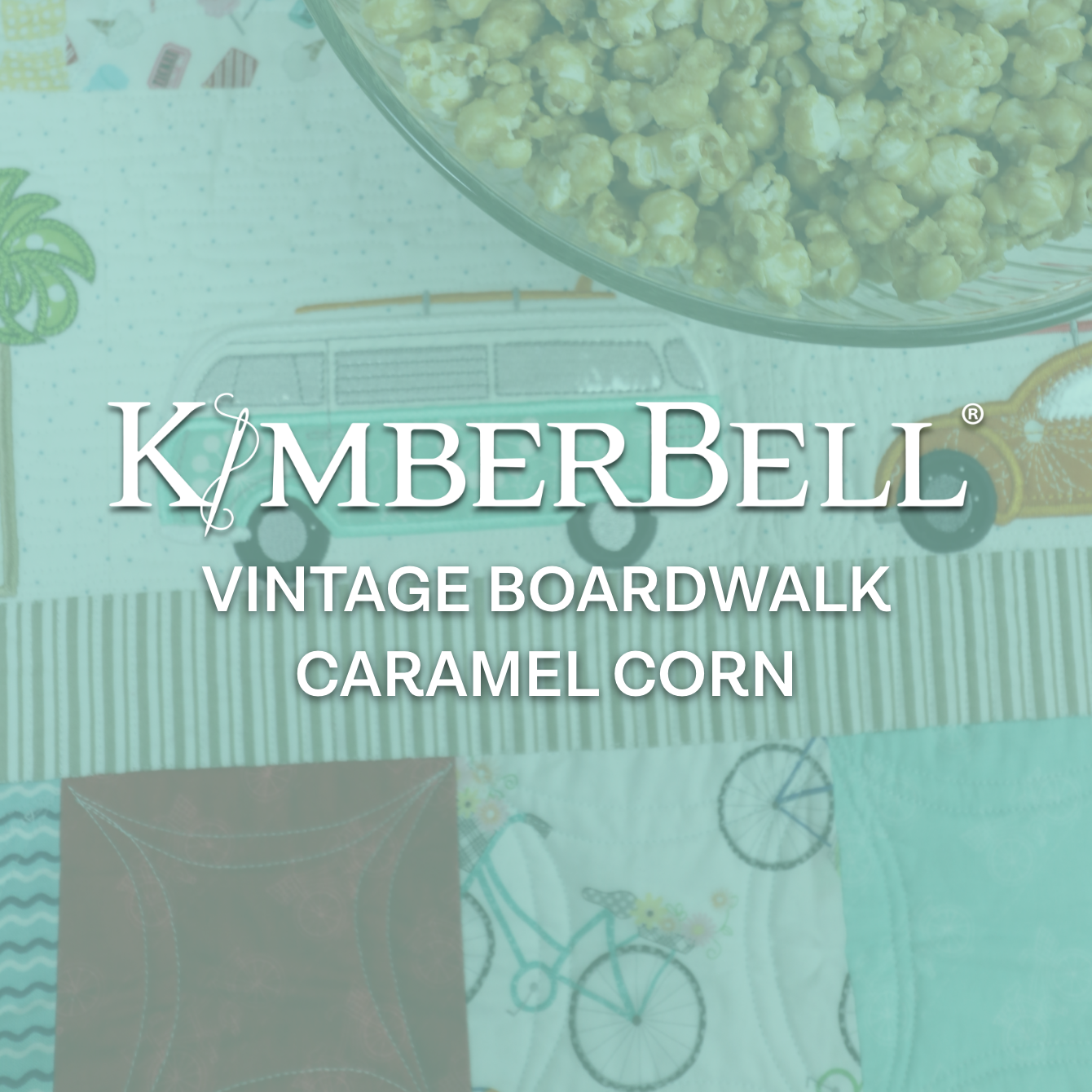Machine Embroidery Glossary of Terms

Below is a list of terms used in embroidery, particularly with home embroidery machines, designs, and instructions. (Additional terms and definitions will be added as needed!)
Applique
A separate piece of fabric sewn into the design in place of stitches. Applique adds dimension and can include a variety of textures, including Kimberbell’s Applique Glitter Sheets, Embroidery Leather, Mylar, Vinyl, and more. From the sparkle of glitter to smooth and shiny leather, applique elevates a design’s aesthetic appeal while decreasing the overall stitch count.
Backing
Stabilizer underneath the fabric being embroidered, sometimes resembling paper, which is often hooped with the fabric . Different types of backing are available, including cut-away, tear-away, and wash-away in various weights. The purpose of backing is to stabilize the fabric and prevent the fabric from shifting during the embroidery process.
Bean Stitch
Similar to a run stitch, with three stitches placed back and forth between two points. Bean stitches are often used for outlining because they are bolder than a run stitch. At Kimberbell, we often use bean stitches on top of satin stitches for a decorative top stitch!
Bird Nesting
When thread tangles between the fabric being stitched and the needle plate. Bird nesting can cause thread breaks and sewing problems and often results from thread tensions being too loose, the machine not being threaded correctly, or the bobbin case not being inserted properly.
Bobbin
A small, round spool wound with thread used on lockstitch machines, used to link the stitch from underneath the fabric. When purchasing prewound bobbins, please note that home embroidery machines typically use a Style L bobbin. (However, it’s always a good idea to check your machine manual to double-check.) You can also wind your own bobbin for your embroidery machine. As there are different weights of bobbin thread, please check your manual to see which weights are recommended for your machine.
Bobbin Case
The bobbin case securely holds the bobbin in the machine and applies tension to the bobbin thread. A latch mechanism sometimes locks the bobbin case into the hook (which is not the case with drop-in bobbins).
Chenille
A textured embroidery technique that adds a fuzzy, dimensional look. At Kimberbell, we create chenille by layering three fabrics and then stitching rows. Fabric is then cut down the center of the row of stitches and we “tuft” the fabric edges with a nail file or chenille brush to fluff the fabric.
Column Stitch
The column (or satin stitch) is made from very closely-placed zigzag stitches for bold stitching. Column/satin stitches are often used for borders, lettering, and covering the raw edges of applique fabrics.
Cut-away
Stabilizer (backing) used behind the fabric being embroidered to prevent shifting and pulling. Cut-away is available in light, medium, and heavy weights and needs to be trimmed with scissors after embroidery. When sewing Kimberbell feature quilts and Bench Pillows, stabilizer is trimmed to be the same size as the background fabric.
Digitize
Converting artwork into a computerized embroidery file, with each element of the design programmed as a specific stitch type. The digitized program controls every action of the embroidery machine, including thread changes, trims, and other functions. Digitizing was formerly called “punching” because of an earlier method with paper tapes punched with holes.
Digitizer
Someone who uses digitizing software to create digitized embroidery files.
Density
Number of stitches in a specific area.
File Format
Every type of embroidery machine reads a different language, so you’ll need to load the design formatted with the right file extension for your machine. Here’s a quick reference:
| ART | Bernina |
| DST | Tajima, Brother, Husqvarna, Janome, & Pfaff |
| EXP | Bernina |
| HUS | Husqvarna Viking |
| JEF | Janome |
| PES | Brother, Baby Lock |
| VIP | Husqvarna Viking, Pfaff |
| VP3 | Husqvarna Viking |
| XXX | Singer |
Fill Stitches
Also known as tatami stitches, fill stitches are made from a series of run stitches and are used to cover large areas. Fill stitches can run in multiple directions and have a generally flat look. Fill stitches can also be created with satin stitches.
Flexible Foam Interfacing
Provides a puffy dimension when stitched under fabric.
Float
Unhooped stabilizer placed between the fabric and the hooped stabilizer, providing additional support.
Fringe
An embroidery technique that creates dimensional loops. Fringe designs are digitized with rows of satin stitches, held in place by a row of smaller satin stitching or fill stitches. The bobbin stitches are then clipped from behind and fluffed from the front.
Gapping
When the fabric is seen either in the middle of an embroidery design or on the edges.
Hooping
The process where fabric and stabilizer are framed and secured inside the embroidery hoop.
Hoops
Hoops attach to the embroidery machine pantograph and grip the fabric tightly between an inner and outer ring.
Hoop Sizes
Hoop sizes are generally 4x4”, 5x7”, 6x10”, 8x12”, and 9x14”. These sizes are not the same as the sewing field of an embroidery design. The design will always be smaller than the hoop, as the machine cannot sew too closely to the edge of the internal hoop.
In-the-Hoop
A project completed, from start to finish, in the embroidery hoop. For example, a Kimberbell Zipper Pouch is created entirely in-the-hoop, including the zipper.
Jump Stitch
Jump stitches are used to move the needle from one point in an embroidery design to another, creating stitches that are longer than the machine would normally allow. These lines of thread must later be handclipped away. (Some machines automatically clip jump stitches.)
Looping
Loops on the surface of embroidery, generally caused by tension problems or a skipped stitch.
Moss Stitch
Another name for chenille (please see above).
Needle
The device that carries the thread through the fabric to interlock with the bobbin thread. Commercial embroidery machines use needles with a round shank; home embroidery machines use needles with a flat-sided shank. A common needle size for a home embroidery machine is 75/11.
Pantograph
The Pantograph is used to attach the hoop to the embroidery machine and can be moved on an X and Y axis.
Paper Tape
A semi-transparent tape used to secure fabric in-the-hoop for machine embroidery projects. Kimberbell Paper Tape does not leave sticky residue on the needle, easily tears away from stitches, and can be used on the underside of the hoop without rolling.
Piecing
Many small pieces of fabric sewn together (often called patchwork). At Kimberbell, we do a lot of piecing in-the-hoop!
Puckering
When fabric is gathered by the stitches, bunching into little puckers. Puckering is often caused by loose hooping, insufficient stabilizer, and incorrect thread tensions or stitch density.
Pull and Push Compensation
Stitches always push and pull the fabric during the embroidery process. Digitizers program a degree of intentional distortion into the embroidery design to compensate.
Run Stitch
Run stitches (or running stitches) are made when a single stitch is formed between two points.
Satin Stitches
The satin stitch (or column stitch) is made from very closely placed zigzag stitches for bold stitching. Column/satin stitches are often used for borders, lettering, and covering the raw edges of applique fabric.
SPI
Abbreviation for Stitches Per Inch.
SPM
Abbreviation for Stitches Per Minute.
Stabilizer
A woven or non-woven material used underneath the item being embroidered. Stabilizer provides support, prevents shifting during embroidery, and is available in a variety of types and weights, including cut-away, tear-way, wash-away, and more.
Stitch Count
The number of stitches used in an embroidery design.
Tack-down Stitch
The initial stitches that hold applique fabric in place.
Tatami Stitches
Also known as fill stitches, tatami stitches are a series of run stitches used to cover large areas. Different fill patterns can be created by changing the length, angle, and sequence of the stitches.
Tear-away
Stabilizer (backing) used behind fabric being embroidered to prevent shifting and pulling. Tear-away is available in various weights and tears easily away after embroidery is complete.
Tension
Tautness of the thread. Quality embroidery depends upon proper thread tension, which can be adjusted on the machine and bobbin. When looking at the underside of a satin (column) stitch,
about ⅔ of the thread should be needle thread and ⅓ should be bobbin thread.
Topping
Stabilizer placed on top of fabric being embroidered to prevent stitches from sinking into the pile. Topping can include tear-away and wash-away.
Underlay
Stitching put underneath the embroidery design to stabilize the fabric and raise the design so detail isn’t lost.
Wash-away
Stabilizer that dissolves in water after embroidery. Projects such as freestanding lace are embroidered on wash-away. After rinsing the design in water, only the stitching is left behind.



